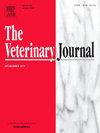Diaphragm ultrasound as a tool to study respiratory function in dogs: A validation study correlating sonographic findings with oesophageal pressure and spirometry during mechanical ventilation and spontaneous breathing
IF 3.1
2区 农林科学
Q1 VETERINARY SCIENCES
引用次数: 0
Abstract
This prospective observational study investigated the correlation between diaphragmatic ultrasound indices (movement and thickening fraction) and trans-diaphragmatic, oesophageal, or transpulmonary pressures, as well as tidal volumes, in anaesthetised dogs. Fifty-seven dogs of various breeds undergoing different procedures were studied under mechanical ventilation at three tidal volumes (5, 10, and 20 ml/kg) and during spontaneous breathing post-ventilation.
Diaphragmatic movement was evaluated with a microconvex probe in M-mode using the transversal plane during mechanical ventilation, and both transversal and longitudinal planes during spontaneous breathing. Diaphragmatic thickening fraction was assessed with a linear probe using M-mode and B-mode scans during spontaneous breathing. Oesophageal and gastric pressures were measured via a nasogastric feeding tube, with data collected across three respiratory cycles. Transpulmonary pressure strongly correlated with diaphragmatic excursion during mechanical ventilation (rho =.81; P < .001). Moderate correlations were observed between tidal volume and diaphragmatic excursion during spontaneous breathing (rho =.72 for longitudinal and.70 for transversal planes; P < .001). Fair correlations were found between oesophageal pressure and diaphragmatic slope during spontaneous breathing (rho =.56 for longitudinal and.46 for transversal planes; P < .001). Longitudinal and transversal planes strongly correlated for excursion (rho =.94; P < .001) and slope (rho =.91; P < .001), with no fixed bias. Diaphragmatic thickening fraction did not correlate with oesophageal pressure (rho =.26 for B-mode and .129 for M-mode; P = .051 and .34, respectively). These findings highlight ultrasound as a promising tool for assessing diaphragmatic function in veterinary medicine.
横膈膜超声作为研究犬呼吸功能的工具:一项将超声结果与机械通气和自主呼吸期间食管压力和肺活量测定相关联的验证研究。
这项前瞻性观察性研究调查了麻醉犬的膈超声指数(运动和增厚分数)与经膈、食管或经肺压力以及潮气量之间的相关性。研究了57只不同品种的狗在3个潮气量(5、10和20ml/kg)下机械通气和通气后自主呼吸的情况。用微凸探针在m模式下测量机械通气时横平面和自主呼吸时横平面和纵平面的膈肌运动。自发性呼吸时,用线性探头m -模式和b -模式扫描评估膈肌增厚分数。通过鼻胃管测量食管和胃压力,并收集三个呼吸周期的数据。机械通气时肺压与膈移位密切相关(rho = 0.81;P
本文章由计算机程序翻译,如有差异,请以英文原文为准。
求助全文
约1分钟内获得全文
求助全文
来源期刊

Veterinary journal
农林科学-兽医学
CiteScore
4.10
自引率
4.50%
发文量
79
审稿时长
40 days
期刊介绍:
The Veterinary Journal (established 1875) publishes worldwide contributions on all aspects of veterinary science and its related subjects. It provides regular book reviews and a short communications section. The journal regularly commissions topical reviews and commentaries on features of major importance. Research areas include infectious diseases, applied biochemistry, parasitology, endocrinology, microbiology, immunology, pathology, pharmacology, physiology, molecular biology, immunogenetics, surgery, ophthalmology, dermatology and oncology.
 求助内容:
求助内容: 应助结果提醒方式:
应助结果提醒方式:


